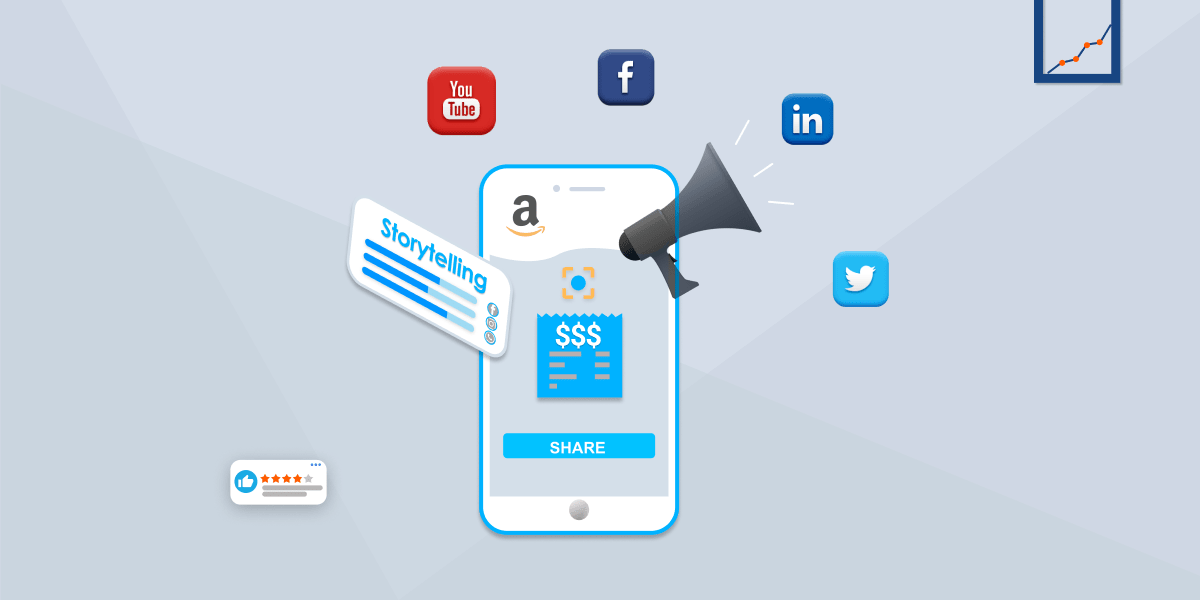
Social media is changing the way we communicate with one another and how consumers interact with businesses. Your brand’s stories through social media channels can make or break a potential customer’s decision to purchase from you. If you’re searching for ways to improve your social media efforts to generate business revenue, then here are 21 ways to use storytelling in social media to increase sales.
Before you learn about publishing social media content for your brand, be sure to download your free storytelling social media strategy template. Use it as a guide to ensure that all your brand’s future content centers around a unified message, and your business will begin generating more sales from social platforms.
Now, let’s discuss why storytelling is a powerful tool for brand owners to build a broader customer base using social media.
What Is Storytelling?
When most people hear the word “storytelling,” they think about the times their teacher read books aloud during primary education classes. Yet, there’s a lot more to storytelling than simply reading a book or watching a film.
Historically, storytelling is a social and cultural activity that involves sharing information with others to pass down the tradition. However, storytelling in a modern sense is about more than transferring knowledge. A fantastic story can also entertain, educate, and instill morals within our society.
Why Is Storytelling Effective?
Stories are incredibly compelling because they’re easy to remember, simple to share with others, and imagination stimulating. Think of it this way, would you prefer someone to list off 100-facts, or tie the same information into a well-told story?
If you were to share 100 facts about cryptology, for example, most people would fall to sleep when you start discussing cryptology and mathematics.
But if you take those same facts, add in World War II, explain how Germany thought they could create an unbreakable code using an “enigma machine,” and discuss how one man was able to decipher private military messages, then you have a fascinating story that people will enjoy hearing.
A great story draws you in by incorporating diverse characters, maintaining the element of surprise, and showing how individuals change as they experience new things. And it’s these same storytelling techniques that you can use to engage an audience on social media, to build their interest in your brand, your product offerings, and make more sales.
What Is Social Media Brand Storytelling?
Back in 1997, Andrew Weinreich launched the first social media site SixDegrees.com. It essentially lets people connect with other individuals within their sphere of influence to create new friendships and develop professional connections. Although it wasn’t a social media platform for brands, it made the model for popular social networks like Facebook and LinkedIn.
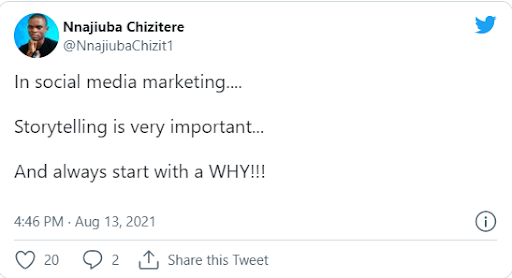
Today, there are dozens of social media sites where brands share social content, connect with an active audience, and promote products. The brands that are most successful on social media platforms consistently use storytelling to grow and engage their audience.
Social media brand storytelling is about providing an authentic representation of your brand while telling a story that is uniquely yours. It’s about more than simply showing off your brand’s products. Instead, the goal of storytelling on social media is to share a story about your brand or products, starting a conversation with other individuals and companies.
Importance Of Storytelling On Social Media

Storytelling using social media is vital if you want prospective customers to understand why they should choose your products and services instead of similar offerings from your competitors.
There are two significant reasons why storytelling is so important. First, it helps your brand achieve its internal goals, and second, it’s the easiest way to share your brand’s external goals with prospective customers.
Internal Vs. External Goals For Social Media Storytelling
Although your internal reason for storytelling on social media might be to sell more products, generate additional traffic to your website, or build brand recognition, you should also focus on an external goal.
Your brand’s external goal should relate to the needs of your customers and audience. After all, it’s impossible to convince anyone to buy a product by explaining your company’s profit margins and revenue targets.
For example, during the 2007 Apple keynote, Steve Jobs introduced the iPhone as a device that “fits beautifully in the palm of your hand.” Had he said, “it’s a money grab, I just want to be rich,” the iPhone likely wouldn’t have been the most popular cell phone today.
Instead, Job’s external goal was for Apple to create an incredibly functional phone by reducing the likelihood that calls would drop, but more importantly, he wanted the iPhone to fit comfortably in your hand.
The key takeaway here is that storytelling helps your brand connect with an audience by sharing the details of your business that they would otherwise never know. You hook people in by creating honest, entertaining, and informative content that your prospective customers enjoy reading, watching, and sharing.
With that in mind, what makes storytelling an effective strategy for generating social media sales? Let’s discuss why your brand should always focus on storytelling while initiating a social media marketing plan.
Why Is Social Media Storytelling Effective For Generating Sales?
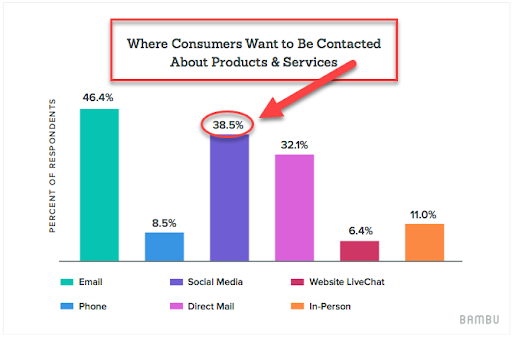
Social media storytelling is an effective strategy for generating brand sales for several reasons:
- Businesses spend billions of dollars every year on advertising. By sharing your brand’s story and connecting with an audience on social media, your content will be unforgettable in a world where consumers have a lot to ignore.
- Social media storytelling can turn buyers to customers and customers to raving fans. By creating brand stories that your audience relates to, you’ll build a loyal audience with a deep emotional connection with your content.
- Social media helps you connect with buyers who want more from the businesses they support. More specifically, customers are searching for brands that make an impact or support a cause. Storytelling is one way to tell your audience which causes your brand supports.
Now that you understand why you should use social media storytelling to enhance your brand on social media, are you ready to discover the process for creating unique content? The following section will explain various techniques that brand owners use to build an audience and generate sales.
21 Ways To Use Social Media Storytelling Techniques To Increase Sales

In the United States, a large majority of people use social media. According to Pew Research, as of 2020, about 71% percent of Americans are on at least one social network, and 55% percent are active every day. Social media helps businesses to be more accessible and visible. It’s a great way to connect with customers, promote your brand and increase business revenue.
With that in mind, let’s discuss how to start telling your brand’s story on social media sites like Facebook, LinkedIn, and Twitter.
Start With The Basics
These simple tips set the foundation for your social media storytelling initiatives. Be sure to consider these techniques if you want to ensure the highest chances of success.
1: What’s Your Brand’s Area Of Expertise?
Before you create your brand story, it’s essential to consider its strengths and weaknesses. Storytelling is your opportunity to provide deeper meaning to the products and services you offer to customers.
As your brand matures, you’ll uncover new opportunities. But for now, focus on a central message you’d like to communicate that highlights your brand’s strengths. You’ll create a more powerful story that resonates with your custom audience by considering how you want to build your brand narrative.
2: Which Topics Do Your Prospective Customers Expect?
While you’re considering your brand’s area of expertise, make a list of the topics your prospective customers expect you to discuss.
Compelling brand storytelling is only partially about your brand and its products. The focus should always be on the information your prospective customers would like to know. You can tie your products or services into the discussion by presenting them as solutions to your customer’s goals.
Social media is the platform to connect with a broader audience, but if you’re not speaking about the topics they want to hear, they’ll quickly lose interest. While planning your brand storytelling, always ask yourself if the information you’re planning to share on social media is relevant to your audience.
3: Why Should Other’s Care About Your Brand?
Convincing customers to buy your products begins with an authentic and captivating story. However, your audience won’t support your brand without first understanding how it fits into their lifestyle. Play into your audience’s belief system through a powerful story that explains how your products could enhance your customer’s lives.
4: Have An Internal And External Goal
Earlier, you learned about setting internal and external goals that you would like to achieve from storytelling on social media. Now it’s time to think about how you’ll define and measure those goals.
Your brand can use engagement or reach stats to determine whether you’re achieving the goals you’ve set. Use social media analytics and sales reports to determine how successful storytelling works for your brand.
External goals should relate to the overall brand purpose and objectives. Always create stories that share what your business does and how it can impact others. This technique of always considering your internal and external goals will keep your brand storytelling relevant and consistent.
Establish Your Brand Story
Now that you’ve defined your goals and established a plan that will ensure you achieve success through social media storytelling, it’s time to create your brand story. To help entrepreneurs develop a brand story, let’s discuss a few tips while also exploring examples of social media storytelling from brands that use this strategy effectively.
5: Create Engaging Content Around A Specific Theme
At this point, you understand your brand’s strengths and the information your customers would like to know about your business. Now, it’s time to share your message with the world, while being sure to use a bit of creativity.
Consider Nike’s Equality campaign. Nike has mastered brand storytelling using social media because they have well-defined external goals. Watch this video, and notice how Nike highlights their products while incorporating a narrative that’s about more tells a story that’s larger than the brand.
6: Establish A Brand “Voice.”
Establishing a strong brand voice is essential if you want to break through the clutter. Define how you want your social media followers to think about your brand and craft a story that uses an appropriate brand voice.
Every brand will have its unique voice. However, it’s best to make your storytelling personable, rather than using corporate speak. After all, people use social media to learn and for entertainment, rather than to fall asleep from corporate lingo.

Here’s an example from Intel, where they share the company’s history without using complex language that social media followers won’t understand. It’s intelligent, without being unrelatable, while also sharing a more extensive social message.
7: Consistently Share Your Brand’s Story
When it comes to storytelling on social media, consistency is critical. Consider how often you’ll post. Publish content too often, and you risk tuning out your audience. If you publish too infrequently, you’ll fail to build a following, and your social media storytelling campaigns will be ineffective.
The goal is to discover how often your audience wants you to publish stories. Some large brands can post multiple times a day, while smaller ones prefer to share content several times a week. Test what works for your brand and follow a consistent social media publishing schedule.
8: Repost Content That Supports Your Central Theme
Sometimes, other brands publish content on social media that focuses on the same topics which matter to your customers. One way to expand your reach is by reposting content with your brand’s thoughts on the issue, which starts a discussion and fosters dialogue.
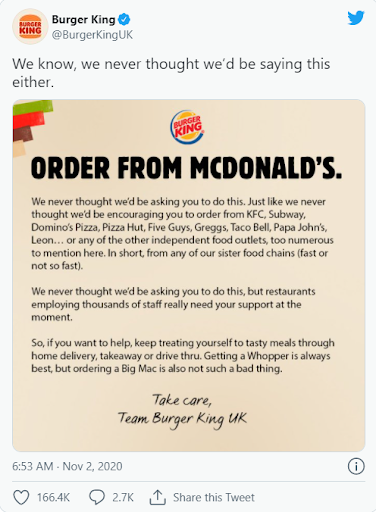
One brand that does this exceptionally well is Burger King. Because of their well-known social media rivalry with McDonald’s, they’ve uncovered some unique ways to build their audience by discussing their unique perspective on competition.
Make Your Story Meaningful To Your Audience
Your brand now has a central message and a consistent publishing schedule. Now it’s time to enhance the “storytelling” power of your social media content. Use these storytelling strategies to engage your audience and compel them to take favorable actions for your business.
9: Turn Your Brand Into The “Hero.”
When storytelling, it’s always good to have a hero. The most engaging stories are typically a battle between a hero and a villain. In storytelling on social media, this means making your brand the solution to your customer’s biggest challenges, weaknesses, and fears.
With this in mind, what can you do to make that happen? Begin by turning your product or service into an essential ingredient in someone else’s success story.
People love success and search for brands that help them achieve their goals. During your social media storytelling, explain how your brand is the hero by exploring the ways your products and services positively impact the lives of others.

Here’s an example from Dawn, who uses social media to tell a story of the unique uses of their product, which can give you a few ideas of how to turn your brand into your story’s hero.
10: Add The Element Of Surprise
Throughout storytelling on social media, be sure to add the element of surprise. Fascinating content is unpredictable and keeps people talking.
Everyone loves surprises. Be creative and craft social media storytelling campaigns that are unexpected yet valuable for the audience. Using storytelling is one way to keep people’s attention while establishing a deep relationship with those who pay attention to your posts.
11: Incorporate Conflict And Resolution
Stories are all about conflict and resolution. Whether you’re telling the story of a romance, an adventure, or a mystery, storytelling on social media needs to have some development that makes an impact — or you risk losing your audience’s interest.
Engage Your Audience
So, you’re ready to take your storytelling to the next level by finding new ways to engage your audience. How do you start? Here are some helpful storytelling tips that increase engagement and make your fans feel special.
12: Share Content From Your Audience
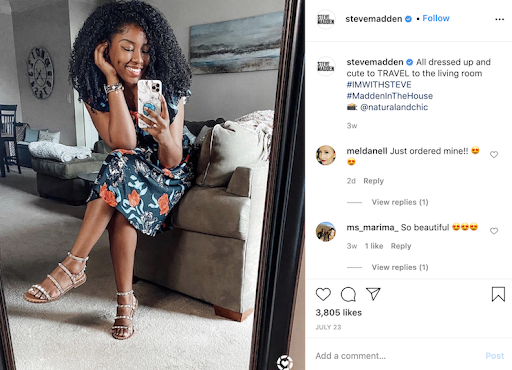
Content posted by others can be an entertaining and effective form of storytelling that rivals any social media content your brand creates. Just make sure that you’re not only sharing exciting posts but also offering a bit of analysis about what makes the content so unique.
Creating unique content for your brand is powerful. However, it’s not the only way to connect with your social media followers and build your audience. Also, be sure to share content that matches your brand’s external goals by sharing content from your audience.
13: Add Storytelling To Your Customer’s Content About Your Brand
When your raving fans share content related to your brand, share your community’s creation with your followers. Turn it into a storytelling opportunity by adding a friendly comment to show your support. You can even ask brand followers if it’s okay to republish their content.
And if your customers are not yet sharing their thoughts about your products or services, don’t worry. You can always run a competition, or have a giveaway, to get people to discuss your products on social media.
Airbnb uses customer-generated content incredibly well by sharing photos of homes people rent on the platform and adding its commentary.
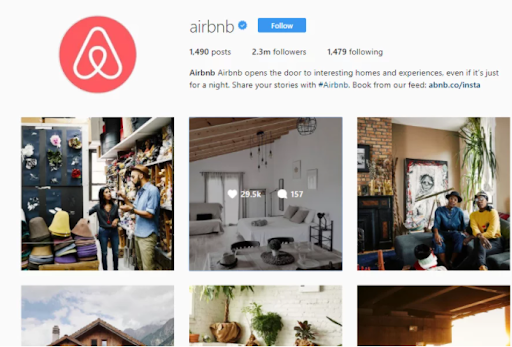
14: Start A Conversation That Drives Your Narrative Forward
There’s a reason it’s called “social media” and not just media. That’s because social media is about creating dialog and sustaining a conversation. Every day your brand has an opportunity to speak with people who use your products and those searching for similar items that you sell.
Use this opportunity to drive your external goals forward and build new relationships with your prospective customers.
15: Include Your Audience In Your Storytelling
One of the best ways to generate sales using social media is by including your customers and users in the storytelling process. Use your storytelling to share your customer’s experiences with your products and your brand. In a sense, including your audience is a way of creating social proof.
This storytelling technique helps prospective customers learn how others use your products while also sharing potential benefits they can expect to receive by purchasing items from your brand.
Use A Mix Of Visual Elements
A mixture of content formats, including text, audio, and visual storytelling, can be a great way to appeal to a larger audience. Facebook, Instagram, Snapchat, and other social media sites let you share different forms of content that your followers love. The following tips cover the visual storytelling formats that will enhance your brand.
16: Incorporate Text Storytelling In The Product Descriptions
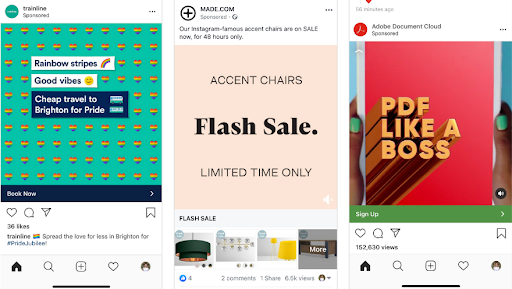
Sometimes sharing a story with your audience takes a few lines of text. For example, not every tweet on Twitter includes videos or images. Create text-based content that shares your brand’s messaging while informing social media followers of essential updates, new products, and other announcements.
17: Expand To Image Storytelling
With visual storytelling, you can share photos, infographics, and animated gifs that showcase your brand’s products and services. It will serve as an excellent preview for social media users interested in what you have to offer but may not be ready to purchase just yet. Plus, images and videos have the best level of engagement and can grow your audience quickly.
18: Share Your Brand’s Story Using Video Content
Video storytelling is also another effective way to share your brand’s messages. It helps your audience discover more about your brand while highlighting your products and services. Additionally, video content gives your social media community a behind-the-scenes look at your business, building trust while also providing entertainment.
Share Relatable Content
Compelling storytelling on social media is all about building a connection and establishing an emotional investment between your brand and its customers. The last several techniques will help you create content that’s relatable to your audience. If your audience can relate to your brand’s stories, chances are they’ll share it as well, which will consequently lead more people into discovering your brand while also increasing sales revenue.
19: Create Quality Brand Content
Through storytelling on social media, you can easily connect with your target market by posting content containing valuable information about the problems they face. Make sure that it is exciting and helpful enough to compel them to share with other people who might also benefit from your brand’s posts. The more you help your audience achieve their goals, the easier it will be to build an audience and generate sales.
20: Explain The History Of Your Brand

While storytelling on social media, start by discussing the founding of your business. Explaining your company history will make it easy for people to understand your external goals and support your organization’s performance. People will also be more inclined to trust you and want to continue hearing stories about your brand.
21: Share Content That Your Brand Believes In
Creating unique brand content and building an audience might seem challenging at first. However, storytelling on social media can be pretty easy if you’re true to your brand’s values and beliefs. Remember this point, and you’re sure to attract people who will purchase your products. By creating brand messaging that other people relate to, you’re sure to find success from social media storytelling.
Final Thoughts On Storytelling In Social Media
In conclusion, your brand is a unique entity that should share its perspective with the world. Social media storytelling is your brand’s opportunity to build an audience that supports your business and the products you offer.
Now that you understand these 21 ways to use social media storytelling to increase sales, how will you incorporate them into your content strategy? Start with an understanding of your internal and external brand goals and use these 21 tips to achieve success for your business.
To create the best possible brand impressions with your audience, you need carefully crafted social media content. Download our free template for a step-by-step guide on preparing an innovative and cohesive marketing message across all of your channels today! Explore the Eric Z Johnson website to download your social media storytelling template and start building a captive buyers list using social media.
Do You Feel Like Your Amazon Business Is In A Rut?
You’re not alone. Many businesses find it difficult to scale on Amazon. That’s where we come in. We are a top-tier, turnkey, performance-based Amazon marketing agency that can help you take your business to the next level.
We have a proven 4-pillar process that helps businesses achieve higher sales, AOVs, ROIs, and other 3-letter acronyms. Let us show you how we can help you achieve the same success. Click here to schedule a call with a strategist.

